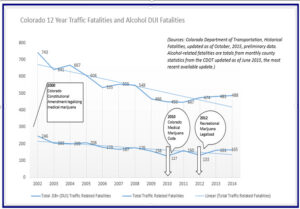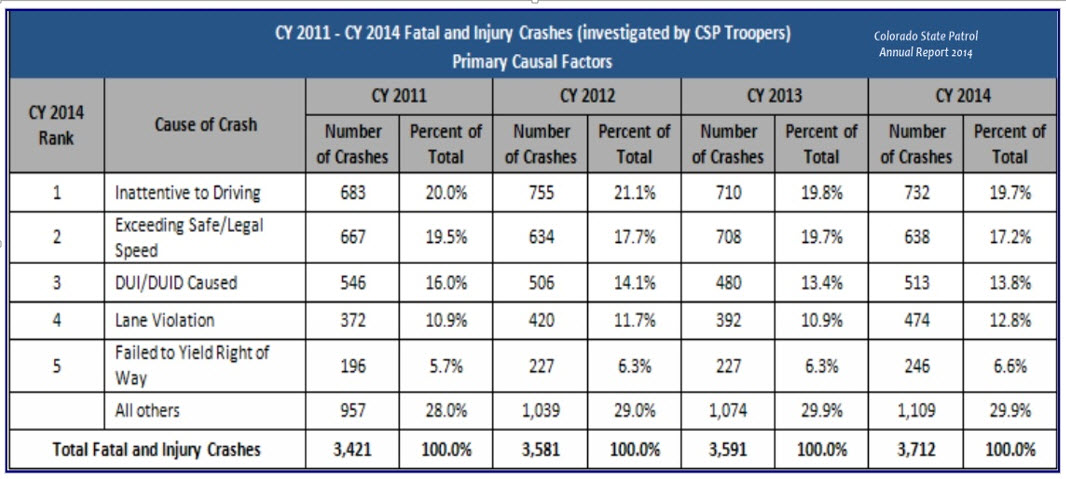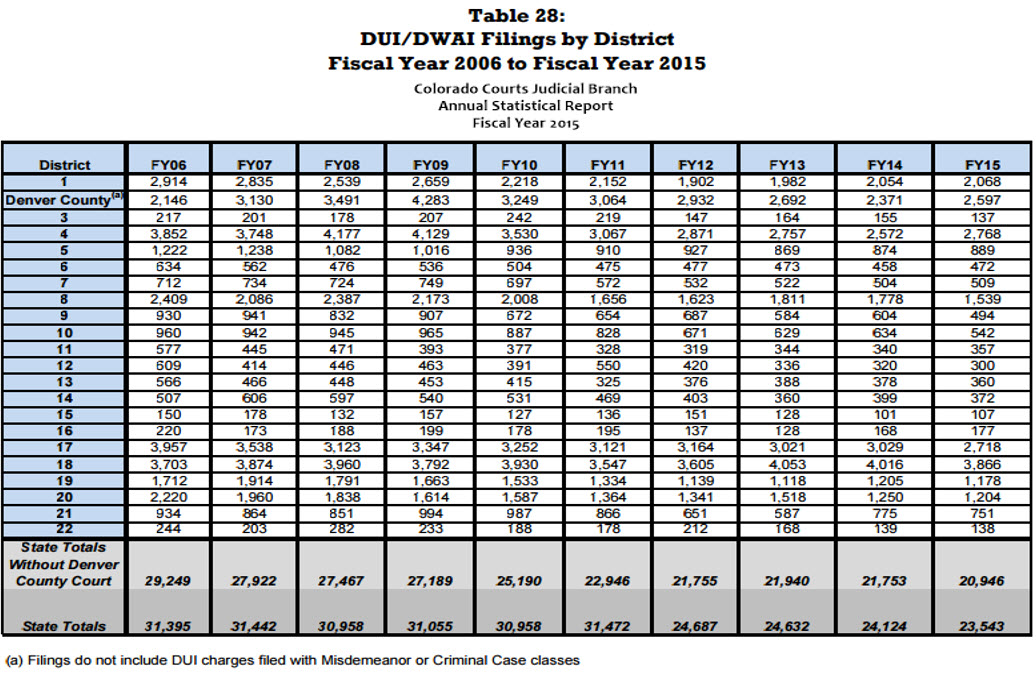Is it Dangerous to Drive in Colorado?
Driving has never been considered a safe activity, and driving under the influence of alcohol, pot, or other reaction-altering drugs increases the risk of serious injury and death—for the driver, and others on the road. But based on percentages of fatal accidents and population, the likelihood of getting killed in a motor vehicle accident on Colorado roads is very slim, with or without the legalization of recreational marijuana, particularly if you’re wearing your seatbelt. A Colorado Department of Transportation “Transportation Facts” report pointed out back in 2011 that half of the traffic fatalities would have survived, had they been wearing a seatbelt. (The National Safety Council reports your chances of dying in a motor vehicle accident nationally are 1:112, and you are more likely to die from intentional self-harm, poisoning, heart disease or cancer.)
Figure 2: DUI Alcohol-related traffic deaths dropped significantly during the years medical and recreational marijuana were legalized.
Many proponents of marijuana legalization held the belief that legalizing marijuana would cause a percentage of drinkers to choose cannabis over a Cabaret or cocktails. Opponents of the legalization of recreational marijuana proclaimed Colorado’s roads would be more dangerous because there would be more fatalities and injuries from additional stoned drivers. Except for a couple reductions in alcohol-related fatalities at the height of new marijuana legalization, things pretty much stayed the same.
Alcohol-related fatalities are in the same ballpark, and non-alcohol related fatalities did see an increase in 2012, 2013 and 2014, albeit a statistically insignificant one from 2013 to 2014. So did drinking drivers switch to pot then go back to drinking? You’ll have to ask the drivers to know for sure, but you can be assured law enforcement agencies, politicians, and policy makers want to find out. There were expected upticks in fatalities, but were these fatalities from cannabis consumers?
Figure 3: Chart from CDOT at Colorado.gov displaying trends in Colorado Fatal Crashes and vehicle miles traveled.
Colorado Accidents Facts – 2012 to 2014
- The population of Colorado increased, and there were more vehicles on the road. The chart (Figure 3) from the Colorado Department of Transportation, available at Colorado.gov, shows that fatal accidents can be reduced, even as vehicle miles traveled increases, but the slight uptick in vehicle miles traveled from 2012 to 2013 is congruent to the slight uptick in fatalities for that year.
- It’s important to recognize that from 2012 to 2013, the number of people that died in traffic accidents increased, but the number of traffic accidents actually decreased from 2012 to 2013.
- From 2013 to 2014 there was a notable increase in fatal accidents, but reports from the Colorado State Police (Figure 4) show only a ½% increase in DUI/DUID injuries and fatalities in 2014 to all fatalities and injuries, but a notable jump of almost 2% for “lane violation” caused injuries. (January 1, 2014 was the first day of legal retail cannabis sales.)
- Investigations by Colorado State Troopers show that from 2011 to 2014, fatal injuries and crashes have decreased.
- In 2011 DUIs and DUIDs were responsible for 16% of state trooper investigated accidents, in 2014 they were only responsible for 13.8%.
- In 2012, recreational marijuana was legal, but the bill wasn’t signed by Governor Hickenlooper until December of 2012, so 2013 would have presumably been the celebratory year for novice cannabis users and drivers.
- But, fatal crashes and DUI/DUID related crashes and injuries decreased from 2012 to 2013. This is shown in the accident investigation tallies shared in the 2015 Annual Report from the Colorado State Patrol (Figure 4).
Figure 4: Source: Colorado State Patrol Annual Report, 2014. Indicates trooper-investigated DUI and DUID fatal and injury crashes saw a decrease from 2011 to 2014. Those years had a new medical marijuana laws in place, the legalization of recreational marijuana and the first year of legal retail marijuana sales in Colorado.
DUI laws apply to driving under the influence of marijuana, as well as alcohol and other drugs. It would be safe to theorize that a DUI recipient who has illegal drugs in their system as well as legal marijuana would have gotten a DUI with or without legalized marijuana. Legalization wasn’t a decision-making factor for those drivers. But a driver who drives under the influence of alcohol, may likely drive under the influence of legal marijuana, but not necessarily illegal marijuana. But if pot and alcohol are in the system, it’s likely these people would have gotten a DUI with or without the pot. Court DUI and DWAI filings include alcohol, pot, and other drug-related driving under the influence and driving while ability impaired.
Did DUIs Increase in Colorado After Marijuana Became Legal?
Figure 5: Data from the Colorado Courts Judicial Branch Annual Statistical Report Fiscal Year 2015. Shows DUI and DWAI filings continued to decrease, despite legalizing recreational marijuana.
Overall, Colorado DUI and DWAI court filings continued to decrease, even after recreational marijuana was signed into law December 10, 2012.
Figure 6: This chart is from the Annual Statistical Report for Fiscal Year 2015 from the Colorado Courts Judicial Branch. Overall, DUI and DWAI filings have continued the downward trend.
Looking at long-term trends (Figure 6, labeled Table 28), we can see that Colorado DUI and DWAI court filings have been on a downward trend since 2006. Denver County did have a spike in increased DUI/DWAI filings in the latest fiscal year, 2014-2015, the year retail sales of marijuana reached new highs. (Pun intended.) But it should also be noted that Colorado had new breathalyzers handed out in 2013 (if things went as scheduled as reported in the CDOT Annual Report 2012, Office of Transportation Safety and Traffic Engineering Branch), and 2014 was the year state-wide marijuana blood testing underwent hefty changes with the Colorado State Police. A pilot saliva testing program started in 2015.
Increased Attention to “Drugged Driving”
In the last few years, most notably in 2014 with the legalizing of legal retail sales of marijuana, there has been increased attention by law enforcement to “driving while high.” A million dollars was spent by the Colorado Department of Transportation for the “Drive High, Get a DUI” awareness program. Without a doubt, police were acutely looking for signs of marijuana. The nation is watching Colorado, and the police are out to find the driving while drugged drivers.
2014 was the first year the Colorado State Police put out a report announcing year-long data collected on marijuana-related DUI violations, which we will report on next. The keyword in the report? “Suspected.” The report is based on suspected use, including “smelling marijuana.” MADD (Mothers Against Drunk Driving) has changed their vision statement to include “help fight drugged driving,” law enforcement officers are attending special training sessions to deal with drugged drivers, and conferences are being held to discuss strategies for documenting the data and dealing with the testing nuances of legalized marijuana. Slides from the 2015 Driving High Conference in Chicago that catered to traffic and law professionals from Colorado, Washington and Oregon, pointed out state patrol schedules changed for more frequent visibility and high visibility efforts were enhanced.
According to the Denver Department of Safety, there were 8 tickets for public display and consumption of marijuana in 2012, and 891 in 2014, and tickets for marijuana violation in parks went from 0 in 2012 to 295 in 2014. However, tickets for possession decreased almost 50% between 2012 and 2014. Clearly, an effort to inform the public to the nuances of new marijuana laws was being made by issuing violations. (Do you really think nobody smoked marijuana in parks prior to 2014?)
Yet, with all this increased attention on drugged drivers and all the cannabis that’s gallivanting around Colorado, Colorado roads remain safe. The most potentially dangerous years are now written into history. Data specialists can get their high crunching numbers while creating benchmarks and warnings for policy-makers and activists. The field for marijuana testing and exploration is wide open, and lawyers will be watching every court decision like a hawk. Do you want to see marijuana legalized nationwide? Don’t drive high. Prohibitionists are looking for ammunition. Enjoy your cannabis, don’t be the bullet.
Read more about legal marijuana:
Part 1: Colorado Recreational Marijuana Legalization: The First Two Years:
>Statistics and Trends Take Time
>Legalizing Recreational Marijuana: As Dangerous as a New iPhone?
>Crime Reported in Colorado
>Denver Crime Statistics 2013 and 2014
>What About Colorado Youth?
>What about Alcohol?
>Are Pot Smokers Ruling the Roads?
Part 2: CO Recreational Marijuana Legalization: The First Two Years Part 2:
>Are Colorado Marijuana Citations High Enough?
>Marijuana Personality Types
>Marijuana-only Driving Citations Were a Small Amount of DUI & DUID Citations
>How Do Proactive Citations Help Accidents?
Part 3: CO Recreational Marijuana Legalization: The First Two Years Part 3:
>Is it Dangerous to Drive in Colorado?
>Colorado Accidents Facts – 2012 to 2014
>Did DUIs Increase in Colorado After marijuana Became Legal?
>Increased Attention to “Drugged Driving”
Part 4: CO Recreational Marijuana Legalization: The First Two Years Part 4:
>Did you hear Marijuana caused 32% more traffic deaths? Let’s Clear the Air
>A 32% increase in marijuana-related traffic deaths? Wow!
>Can This rocky Mountain Colorado Marijuana Impact Report be taken seriously?




